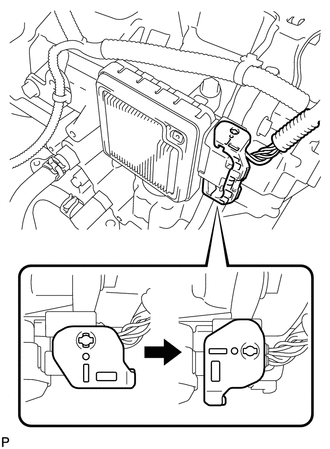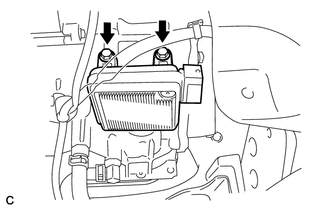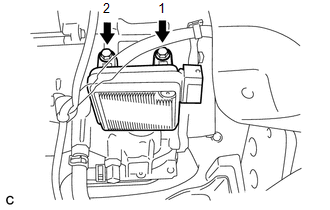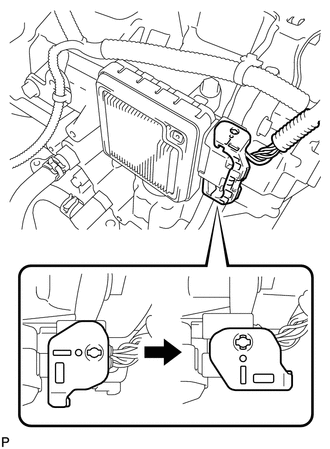Toyota Venza: Tcm
Components
COMPONENTS
ILLUSTRATION
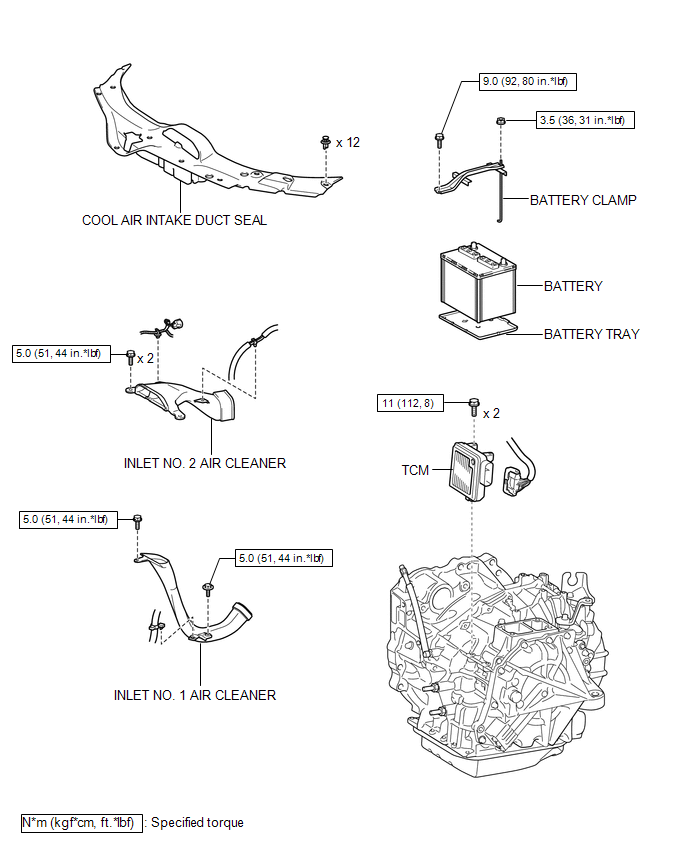
Removal
REMOVAL
CAUTION / NOTICE / HINT
NOTICE:
If automatic transmission parts are replaced, refer to Parts Replacement Compensation
Table to determine if any additional operations are necessary (See page
.gif) ).
).
PROCEDURE
1. DISCONNECT CABLE FROM NEGATIVE BATTERY TERMINAL
NOTICE:
When disconnecting the cable, some systems need to be initialized after the cable
is reconnected (See page .gif) ).
).
2. REMOVE COOL AIR INTAKE DUCT SEAL
.gif)
3. REMOVE INLET NO. 2 AIR CLEANER
.gif)
4. REMOVE BATTERY
.gif)
5. REMOVE INLET NO. 1 AIR CLEANER
.gif)
6. REMOVE TCM
|
(a) Turn the lock lever and disconnect the connector from the TCM. |
|
|
(b) Remove the 2 bolts and TCM from the transaxle. |
|
Installation
INSTALLATION
PROCEDURE
1. INSTALL TCM
(a) Install the TCM to the transaxle.
|
(b) Install and tighten the 2 bolts in the order shown in the illustration. Torque: 11 N·m {112 kgf·cm, 8 ft·lbf} |
|
|
(c) Connect the connector to the TCM. |
|
(d) Turn the lock lever and secure the connector with the lock lever.
2. INSTALL INLET NO. 1 AIR CLEANER
.gif)
3. INSTALL BATTERY
.gif)
4. INSTALL INLET NO. 2 AIR CLEANER
.gif)
5. INSTALL COOL AIR INTAKE DUCT SEAL
.gif)
6. CONNECT CABLE TO NEGATIVE BATTERY TERMINAL
NOTICE:
When disconnecting the cable, some systems need to be initialized after the cable
is reconnected (See page .gif) ).
).
7. CHECK AUTOMATIC TRANSAXLE SYSTEM
NOTICE:
If automatic transmission parts have been replaced, refer to Parts Replacement
Compensation Table to determine if any additional operations are necessary (See
page .gif) ).
).
 Speed Sensor(when Using The Engine Support Bridge)
Speed Sensor(when Using The Engine Support Bridge)
Components
COMPONENTS
ILLUSTRATION
Removal
REMOVAL
PROCEDURE
1. REMOVE TRANSMISSION VALVE BODY ASSEMBLY
See page
2. REMOVE SPEED SENSOR
(a) Disconnect the speed sensor connector.
...
 Torque Converter And Drive Plate
Torque Converter And Drive Plate
Inspection
INSPECTION
PROCEDURE
1. INSPECT TORQUE CONVERTER ASSEMBLY
(a) Inspect the one-way clutch.
(1) Press on the serrations of the stator with a finger and rotate it.
Check ...
Other materials about Toyota Venza:
Removal
REMOVAL
PROCEDURE
1. REMOVE REAR DOOR SCUFF PLATE
2. DISCONNECT REAR DOOR OPENING TRIM WEATHERSTRIP
3. REMOVE TONNEAU COVER ASSEMBLY (w/ Tonneau Cover)
4. REMOVE DECK BOARD ASSEMBLY
5. REMOVE NO. 3 DECK BOARD SUB-ASSEMBLY
6. REMOVE DECK S ...
Diagnostic Trouble Code Chart
DIAGNOSTIC TROUBLE CODE CHART
If a trouble code is displayed during the DTC check, check the circuit listed
for the code in the table below (proceed to the page listed for that circuit).
HINT:
When DTC B1650/32 is detected as a result of troubleshooting f ...
Engine Coolant Temperature Circuit Range / Performance Problem (P0116)
DESCRIPTION
Refer to DTC P0115 (See page ).
DTC No.
DTC Detection Condition
Trouble Area
P0116
When either of the following conditions is met (2 trip detection logic).
During engine ...
0.1173

